Abstract
1. A comparative study of the actions of structurally diverse allosteric modulators on mammalian (human alpha 3 beta 2 gamma 2L) or invertebrate (Drosophila melanogaster Rdl or a splice variant of Rdl) recombinant GABA receptors has been made using the Xenopus laevis oocyte expression system and the two electrode voltage-clamp technique. 2. Oocytes preinjected with the appropriate cRNAs responded to bath applied GABA with a concentration-dependent inward current. EC50 values of 102 +/- 18 microM; 152 +/- 10 microM and 9.8 +/- 1.7 microM were determined for human alpha 3, beta 1 gamma 2L, Rdl splice variant and the Rdl receptors respectively. 3. Pentobarbitone enhanced GABA-evoked currents mediated by either the mammalian or invertebrate receptors. Utilizing the appropriate GABA EC10, the EC50 for potentiation was estimated to be 45 +/- 1 microM, 312 +/- 8 microM and 837 +/- 25 microM for human alpha 3, beta 1 gamma 2L, Rdl splice variant and Rdl receptors respectively. Maximal enhancement (expressed relative to the current induced by the EC10 concentration of GABA where this latter response = 1) at the mammalian receptor (10.2 +/- 1 fold) was greater that at either the Rdl splice variant (5.5 +/- 1.3 fold) or Rdl (7.9 +/- 0.8 fold) receptors. 4. Pentobarbitone directly activated the human alpha 3 beta 1 gamma 2L receptor with an EC50 of 1.2 +/- 0.03 mM and had a maximal effect amounting to 3.3 +/- 0.4 fold of the response evoked by the EC10 concentration of GABA. Currents evoked by pentobarbitone were blocked by 10-30 microM picrotoxin and potentiated by 0.3 microM flunitrazepam. Pentobarbitone did not directly activate the invertebrate GABA receptors. 5. 5 alpha-Pregnan-3 alpha-ol-20-one potentiated GABA-evoked currents mediated by the human alpha 3 beta 1 gamma 2L receptor with an EC50 of 87 +/- 3 nM and a maximal enhancement of 6.7 +/- 0.8 fold of that produced by the GABA EC10 concentration. By contrast, relatively high concentrations (3-10 microM) of this steroid had only a modest effect on the Rdl receptor and its splice variant. 6. A small direct effect of 5 alpha-pregnan-3 alpha-ol-20-one (0.3-10 microM) was detected for the human alpha 3 beta 1 gamma 2L receptor (maximal effect only 0.08 +/- 0.01 times that of the GABA EC10). This response was antagonized by 30 microM picrotoxin and enhanced by flunitrazepam (0.3 microM). 5 alpha-Pregnan-3 alpha-ol-20-one did not directly activate the invertebrate GABA receptors. 7. Propofol enhanced GABA-evoked currents mediated by human alpha 3 beta 1 gamma 2L and Rdl splice variant receptors with EC50 values of 3.5 +/- 0.1 microM and 8 +/- 0.3 microM respectively. The maximal enhancement was similar at the two receptor types (human 11 +/- 1.8 fold; invertebrate 8.8 +/- 1.4 fold that of the GABA EC10). 8. Propofol directly activated the human alpha 3 beta 1 gamma 2L receptor with an EC50 of 129 +/- 10 microM, and at a maximally effective concentration, evoked a current amounting to 3.5 +/- 0.5 times that elicited by a concentration of GABA producing 10% of the maximal response. The response to propofol was blocked by 10-30 microM picrotoxin and enhanced by flunitrazepam (0.3 microM). Propofol did not directly activate the invertebrate Rdl splice variant receptor. 9. GABA-evoked currents mediated by the human alpha 3 beta 1 gamma 2L receptor were potentiated by etomidate (EC50 = 7.7 +/- 0.2 microM) and maximally enhanced to 8 +/- 0.8 fold of the response to an EC10 concentration of GABA. By contrast, the Rdl, or Rdl splice variant forms of the invertebrate GABA receptor were insensitive to the positive allosteric modulating actions of etomidate. Neither the mammalian nor the invertebrate receptors, were directly activated by etomidate. 10. delta-Hexachlorocyclohexane enhanced GABA-evoked currents with EC50 values of 3.4 +/- 0.1 microM and 3.0 +/- 0.1 microM for the human alpha 3 beta 1 gamma 2L receptor and the Rdl splice variant receptor respectively. The maximal enhancement was 4.5
Full text
PDF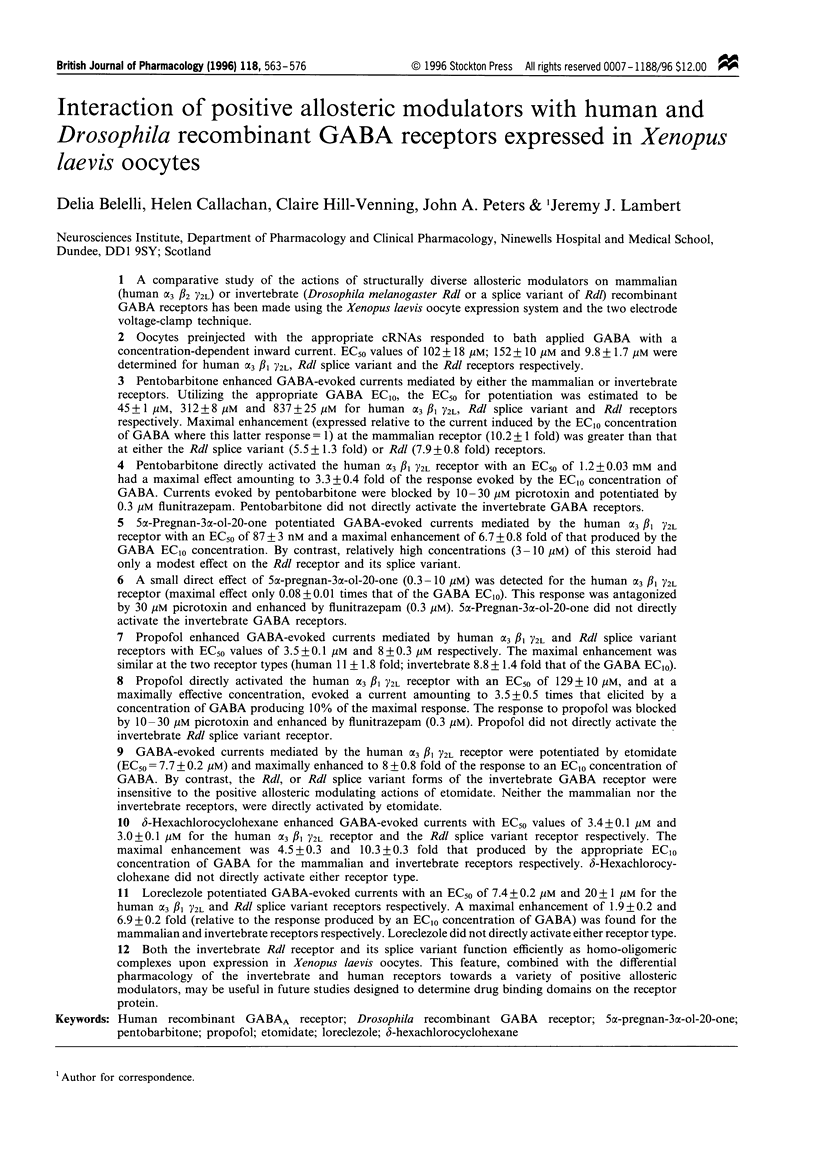

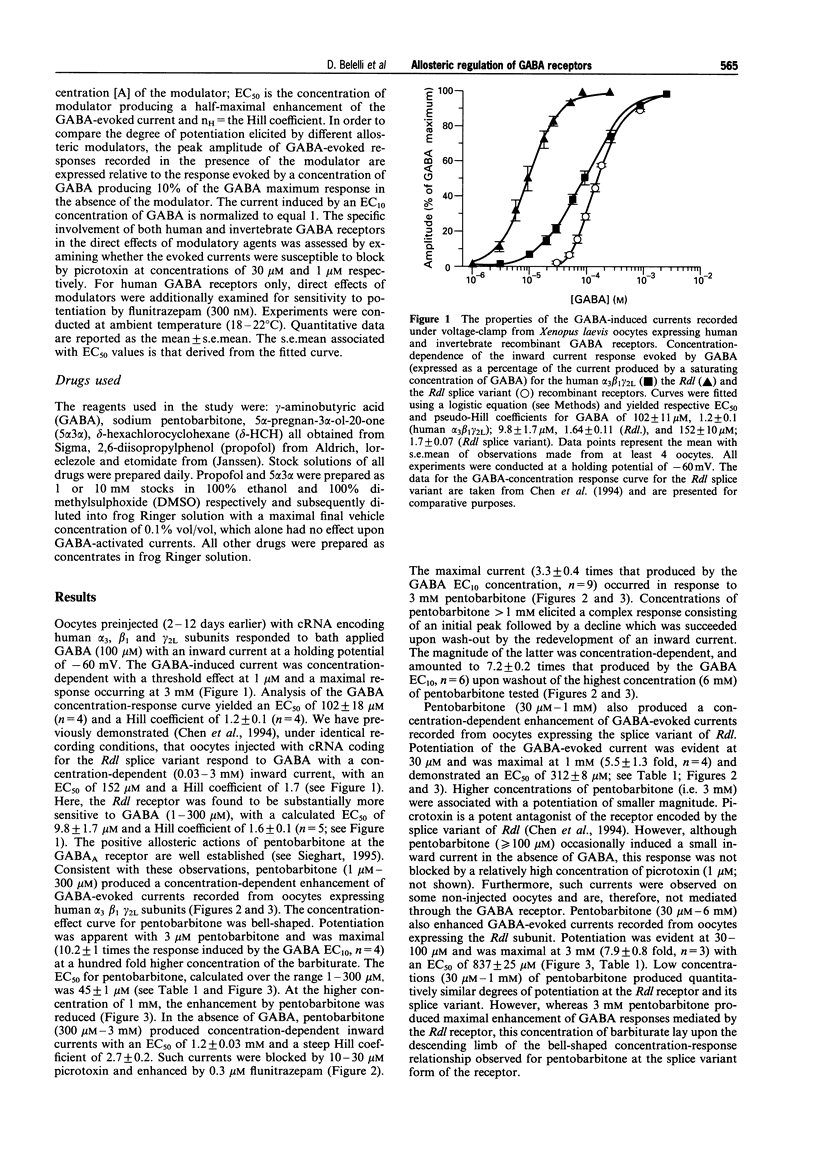

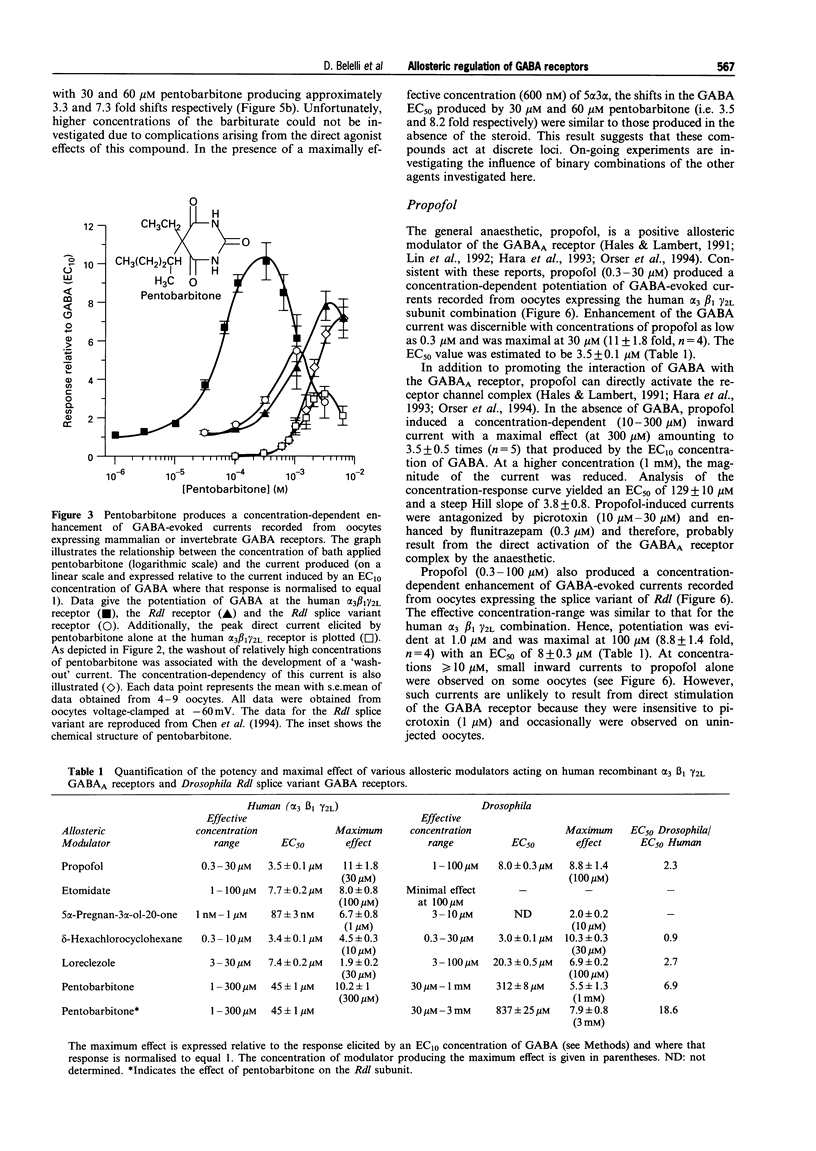
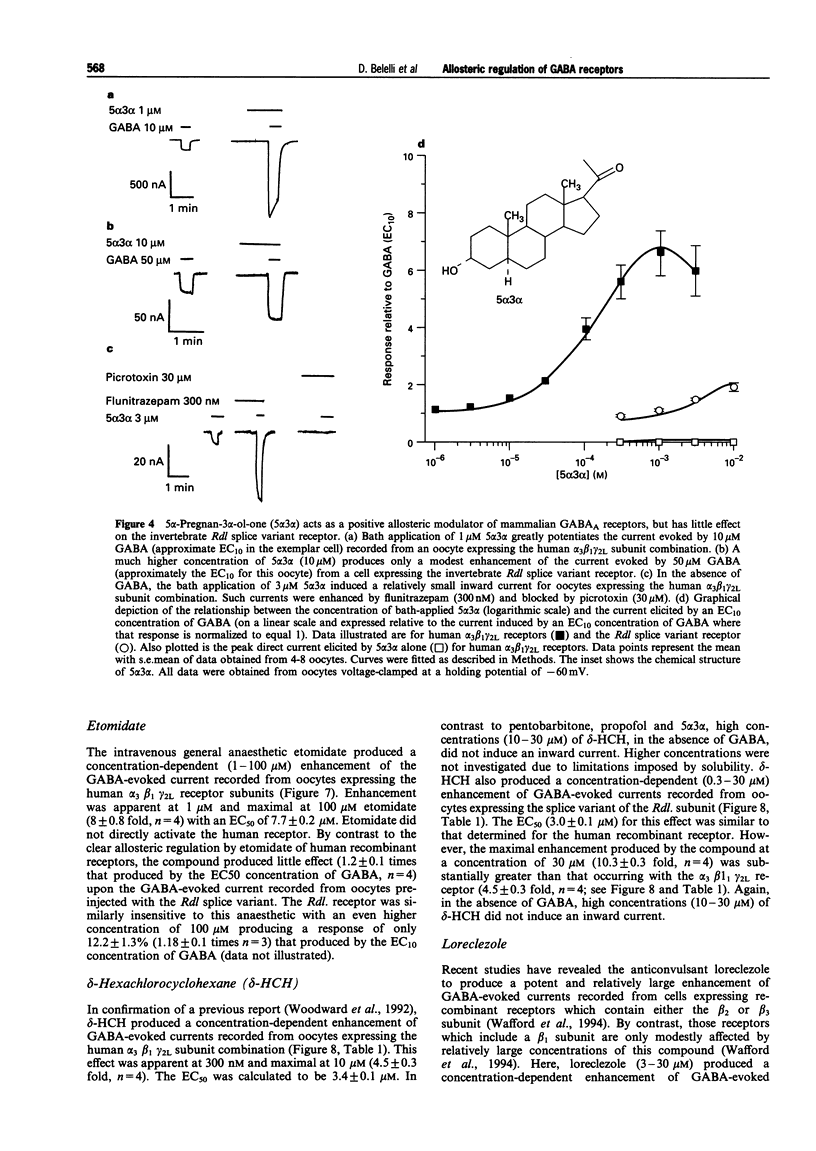

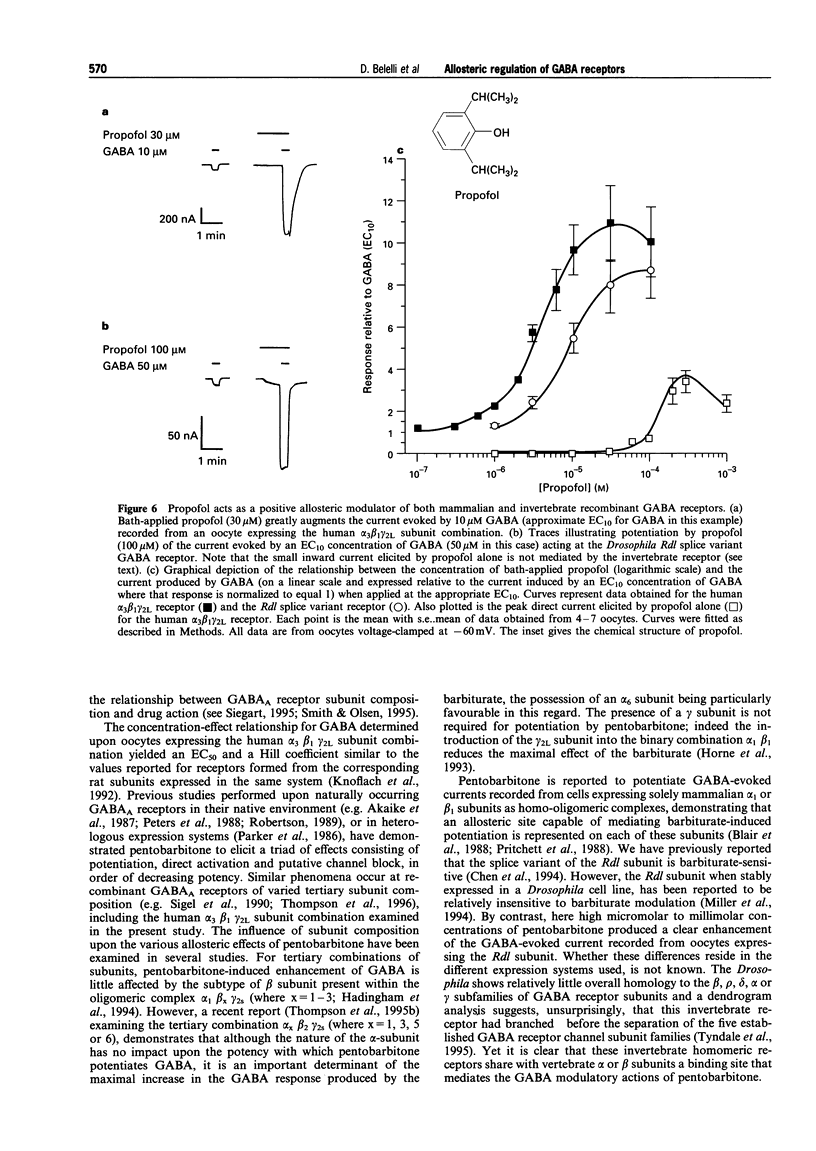
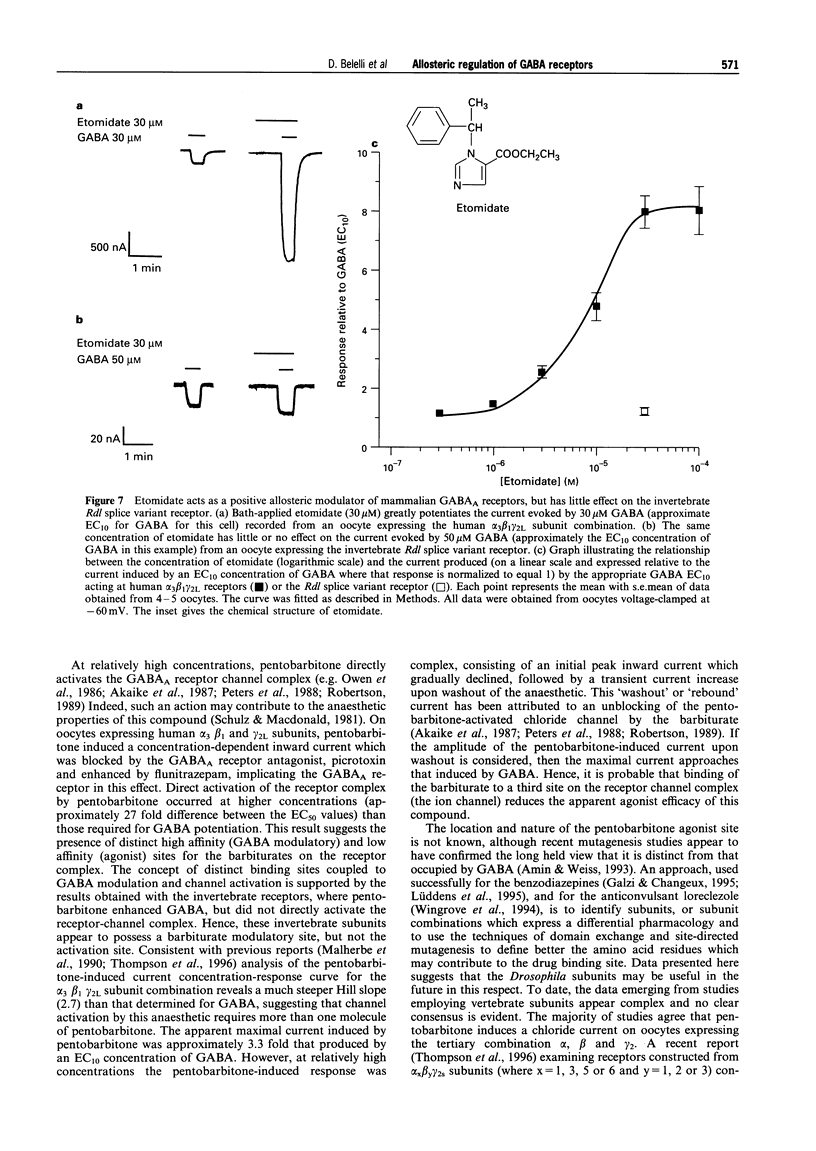
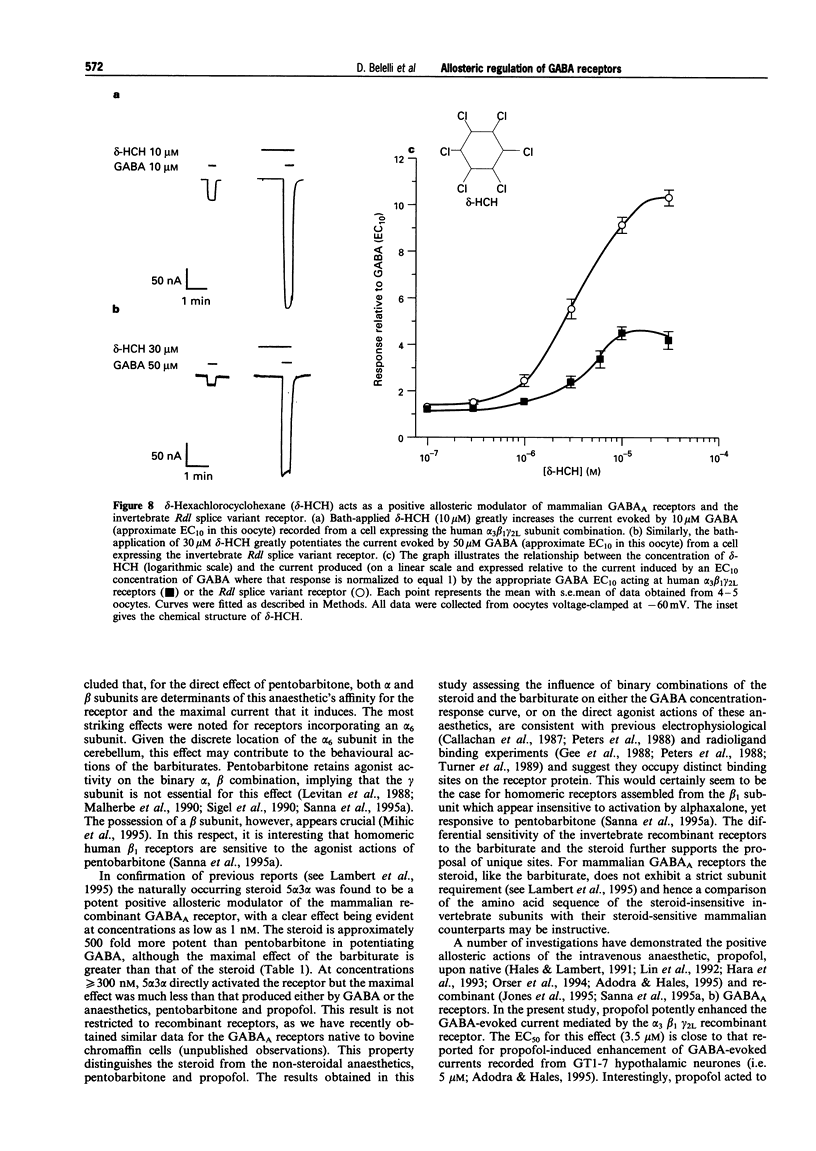

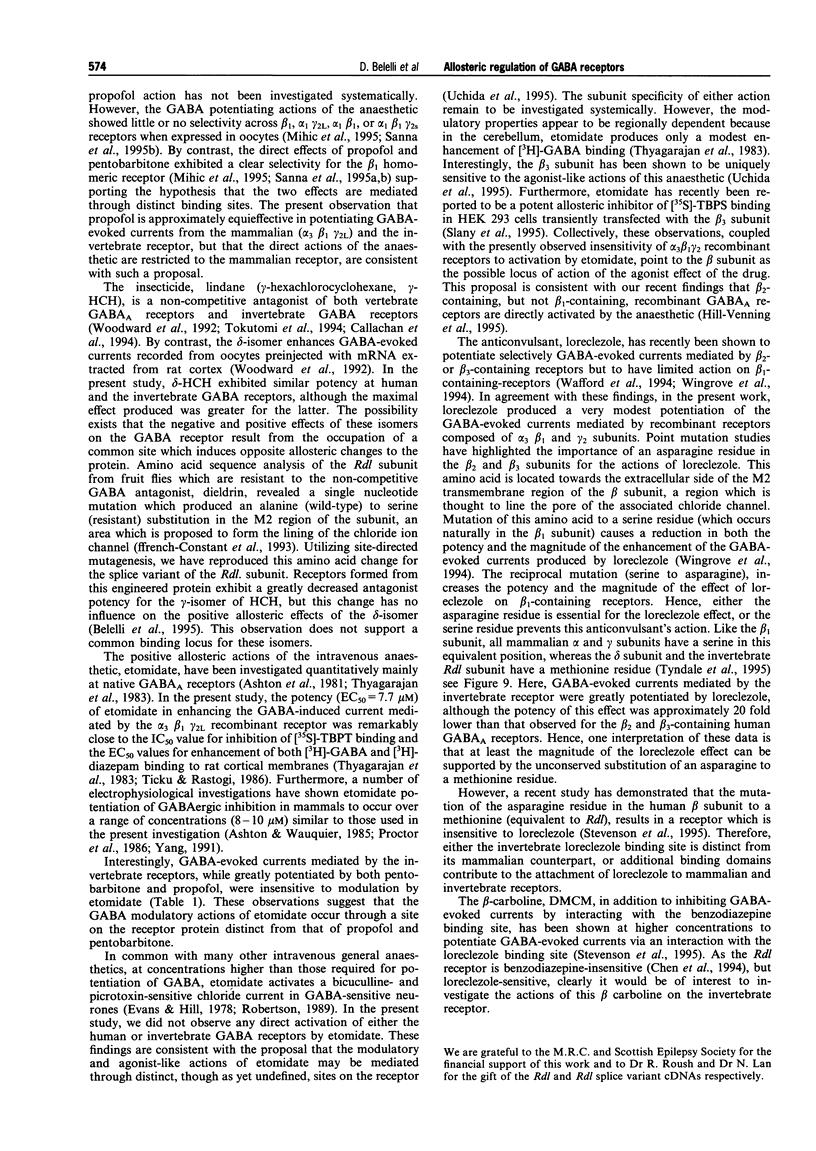


Selected References
These references are in PubMed. This may not be the complete list of references from this article.
- Adodra S., Hales T. G. Potentiation, activation and blockade of GABAA receptors of clonal murine hypothalamic GT1-7 neurones by propofol. Br J Pharmacol. 1995 Jul;115(6):953–960. doi: 10.1111/j.1476-5381.1995.tb15903.x. [DOI] [PMC free article] [PubMed] [Google Scholar]
- Akaike N., Maruyama T., Tokutomi N. Kinetic properties of the pentobarbitone-gated chloride current in frog sensory neurones. J Physiol. 1987 Dec;394:85–98. doi: 10.1113/jphysiol.1987.sp016861. [DOI] [PMC free article] [PubMed] [Google Scholar]
- Amin J., Weiss D. S. GABAA receptor needs two homologous domains of the beta-subunit for activation by GABA but not by pentobarbital. Nature. 1993 Dec 9;366(6455):565–569. doi: 10.1038/366565a0. [DOI] [PubMed] [Google Scholar]
- Ashton D., Geerts R., Waterkeyn C., Leysen J. E. Etomidate stereospecifically stimulates forebrain, but not cerebellar, 3H-diazepam binding. Life Sci. 1981 Dec 21;29(25):2631–2636. doi: 10.1016/0024-3205(81)90637-8. [DOI] [PubMed] [Google Scholar]
- Ashton D., Wauquier A. Modulation of a GABA-ergic inhibitory circuit in the in vitro hippocampus by etomidate isomers. Anesth Analg. 1985 Oct;64(10):975–980. [PubMed] [Google Scholar]
- Blair L. A., Levitan E. S., Marshall J., Dionne V. E., Barnard E. A. Single subunits of the GABAA receptor form ion channels with properties of the native receptor. Science. 1988 Oct 28;242(4878):577–579. doi: 10.1126/science.2845583. [DOI] [PubMed] [Google Scholar]
- Callachan H., Cottrell G. A., Hather N. Y., Lambert J. J., Nooney J. M., Peters J. A. Modulation of the GABAA receptor by progesterone metabolites. Proc R Soc Lond B Biol Sci. 1987 Aug 21;231(1264):359–369. doi: 10.1098/rspb.1987.0049. [DOI] [PubMed] [Google Scholar]
- Chen R., Belelli D., Lambert J. J., Peters J. A., Reyes A., Lan N. C. Cloning and functional expression of a Drosophila gamma-aminobutyric acid receptor. Proc Natl Acad Sci U S A. 1994 Jun 21;91(13):6069–6073. doi: 10.1073/pnas.91.13.6069. [DOI] [PMC free article] [PubMed] [Google Scholar]
- Concas A., Santoro G., Serra M., Sanna E., Biggio G. Neurochemical action of the general anaesthetic propofol on the chloride ion channel coupled with GABAA receptors. Brain Res. 1991 Mar 1;542(2):225–232. doi: 10.1016/0006-8993(91)91571-h. [DOI] [PubMed] [Google Scholar]
- Evans R. H., Hill R. G. GABA-mimetic action of etomidate. Experientia. 1978 Oct 15;34(10):1325–1327. doi: 10.1007/BF01981448. [DOI] [PubMed] [Google Scholar]
- Ffrench-Constant R. H., Rocheleau T. A., Steichen J. C., Chalmers A. E. A point mutation in a Drosophila GABA receptor confers insecticide resistance. Nature. 1993 Jun 3;363(6428):449–451. doi: 10.1038/363449a0. [DOI] [PubMed] [Google Scholar]
- Gee K. W., Bolger M. B., Brinton R. E., Coirini H., McEwen B. S. Steroid modulation of the chloride ionophore in rat brain: structure-activity requirements, regional dependence and mechanism of action. J Pharmacol Exp Ther. 1988 Aug;246(2):803–812. [PubMed] [Google Scholar]
- Hadingham K. L., Wingrove P. B., Wafford K. A., Bain C., Kemp J. A., Palmer K. J., Wilson A. W., Wilcox A. S., Sikela J. M., Ragan C. I. Role of the beta subunit in determining the pharmacology of human gamma-aminobutyric acid type A receptors. Mol Pharmacol. 1993 Dec;44(6):1211–1218. [PubMed] [Google Scholar]
- Hales T. G., Lambert J. J. The actions of propofol on inhibitory amino acid receptors of bovine adrenomedullary chromaffin cells and rodent central neurones. Br J Pharmacol. 1991 Nov;104(3):619–628. doi: 10.1111/j.1476-5381.1991.tb12479.x. [DOI] [PMC free article] [PubMed] [Google Scholar]
- Hara M., Kai Y., Ikemoto Y. Enhancement by propofol of the gamma-aminobutyric acidA response in dissociated hippocampal pyramidal neurons of the rat. Anesthesiology. 1994 Oct;81(4):988–994. doi: 10.1097/00000542-199410000-00026. [DOI] [PubMed] [Google Scholar]
- Hara M., Kai Y., Ikemoto Y. Propofol activates GABAA receptor-chloride ionophore complex in dissociated hippocampal pyramidal neurons of the rat. Anesthesiology. 1993 Oct;79(4):781–788. doi: 10.1097/00000542-199310000-00021. [DOI] [PubMed] [Google Scholar]
- Hope A. G., Downie D. L., Sutherland L., Lambert J. J., Peters J. A., Burchell B. Cloning and functional expression of an apparent splice variant of the murine 5-HT3 receptor A subunit. Eur J Pharmacol. 1993 Apr 15;245(2):187–192. doi: 10.1016/0922-4106(93)90128-v. [DOI] [PubMed] [Google Scholar]
- Horne A. L., Harkness P. C., Hadingham K. L., Whiting P., Kemp J. A. The influence of the gamma 2L subunit on the modulation of responses to GABAA receptor activation. Br J Pharmacol. 1993 Mar;108(3):711–716. doi: 10.1111/j.1476-5381.1993.tb12866.x. [DOI] [PMC free article] [PubMed] [Google Scholar]
- James R., Glen J. B. Synthesis, biological evaluation, and preliminary structure-activity considerations of a series of alkylphenols as intravenous anesthetic agents. J Med Chem. 1980 Dec;23(12):1350–1357. doi: 10.1021/jm00186a013. [DOI] [PubMed] [Google Scholar]
- Jones M. V., Harrison N. L., Pritchett D. B., Hales T. G. Modulation of the GABAA receptor by propofol is independent of the gamma subunit. J Pharmacol Exp Ther. 1995 Aug;274(2):962–968. [PubMed] [Google Scholar]
- Knoflach F., Backus K. H., Giller T., Malherbe P., Pflimlin P., Möhler H., Trube G. Pharmacological and Electrophysiological Properties of Recombinant GABAA Receptors Comprising the alpha3, beta1 and gamma2 Subunits. Eur J Neurosci. 1992 Oct;4(1):1–9. doi: 10.1111/j.1460-9568.1992.tb00103.x. [DOI] [PubMed] [Google Scholar]
- Lambert J. J., Belelli D., Hill-Venning C., Peters J. A. Neurosteroids and GABAA receptor function. Trends Pharmacol Sci. 1995 Sep;16(9):295–303. doi: 10.1016/s0165-6147(00)89058-6. [DOI] [PubMed] [Google Scholar]
- Levitan E. S., Blair L. A., Dionne V. E., Barnard E. A. Biophysical and pharmacological properties of cloned GABAA receptor subunits expressed in Xenopus oocytes. Neuron. 1988 Nov;1(9):773–781. doi: 10.1016/0896-6273(88)90125-0. [DOI] [PubMed] [Google Scholar]
- Lin L. H., Chen L. L., Zirrolli J. A., Harris R. A. General anesthetics potentiate gamma-aminobutyric acid actions on gamma-aminobutyric acidA receptors expressed by Xenopus oocytes: lack of involvement of intracellular calcium. J Pharmacol Exp Ther. 1992 Nov;263(2):569–578. [PubMed] [Google Scholar]
- Lüddens H., Korpi E. R., Seeburg P. H. GABAA/benzodiazepine receptor heterogeneity: neurophysiological implications. Neuropharmacology. 1995 Mar;34(3):245–254. doi: 10.1016/0028-3908(94)00158-o. [DOI] [PubMed] [Google Scholar]
- Malherbe P., Sigel E., Baur R., Persohn E., Richards J. G., Mohler H. Functional characteristics and sites of gene expression of the alpha 1, beta 1, gamma 2-isoform of the rat GABAA receptor. J Neurosci. 1990 Jul;10(7):2330–2337. doi: 10.1523/JNEUROSCI.10-07-02330.1990. [DOI] [PMC free article] [PubMed] [Google Scholar]
- Mihic S. J., Sanna E., Whiting P. J., Harris R. A. Pharmacology of recombinant GABAA receptors. Adv Biochem Psychopharmacol. 1995;48:17–40. [PubMed] [Google Scholar]
- Orser B. A., Wang L. Y., Pennefather P. S., MacDonald J. F. Propofol modulates activation and desensitization of GABAA receptors in cultured murine hippocampal neurons. J Neurosci. 1994 Dec;14(12):7747–7760. doi: 10.1523/JNEUROSCI.14-12-07747.1994. [DOI] [PMC free article] [PubMed] [Google Scholar]
- Parker I., Gundersen C. B., Miledi R. Actions of pentobarbital on rat brain receptors expressed in Xenopus oocytes. J Neurosci. 1986 Aug;6(8):2290–2297. doi: 10.1523/JNEUROSCI.06-08-02290.1986. [DOI] [PMC free article] [PubMed] [Google Scholar]
- Peters J. A., Kirkness E. F., Callachan H., Lambert J. J., Turner A. J. Modulation of the GABAA receptor by depressant barbiturates and pregnane steroids. Br J Pharmacol. 1988 Aug;94(4):1257–1269. doi: 10.1111/j.1476-5381.1988.tb11646.x. [DOI] [PMC free article] [PubMed] [Google Scholar]
- Prince R. J., Simmonds M. A. Temperature and anion dependence of allosteric interactions at the gamma-aminobutyric acid-benzodiazepine receptor. Biochem Pharmacol. 1992 Oct 6;44(7):1297–1302. doi: 10.1016/0006-2952(92)90529-r. [DOI] [PubMed] [Google Scholar]
- Pritchett D. B., Sontheimer H., Gorman C. M., Kettenmann H., Seeburg P. H., Schofield P. R. Transient expression shows ligand gating and allosteric potentiation of GABAA receptor subunits. Science. 1988 Dec 2;242(4883):1306–1308. doi: 10.1126/science.2848320. [DOI] [PubMed] [Google Scholar]
- Proctor W. R., Mynlieff M., Dunwiddie T. V. Facilitatory action of etomidate and pentobarbital on recurrent inhibition in rat hippocampal pyramidal neurons. J Neurosci. 1986 Nov;6(11):3161–3168. doi: 10.1523/JNEUROSCI.06-11-03161.1986. [DOI] [PMC free article] [PubMed] [Google Scholar]
- Robertson B. Actions of anaesthetics and avermectin on GABAA chloride channels in mammalian dorsal root ganglion neurones. Br J Pharmacol. 1989 Sep;98(1):167–176. doi: 10.1111/j.1476-5381.1989.tb16878.x. [DOI] [PMC free article] [PubMed] [Google Scholar]
- Sanna E., Garau F., Harris R. A. Novel properties of homomeric beta 1 gamma-aminobutyric acid type A receptors: actions of the anesthetics propofol and pentobarbital. Mol Pharmacol. 1995 Feb;47(2):213–217. [PubMed] [Google Scholar]
- Sanna E., Mascia M. P., Klein R. L., Whiting P. J., Biggio G., Harris R. A. Actions of the general anesthetic propofol on recombinant human GABAA receptors: influence of receptor subunits. J Pharmacol Exp Ther. 1995 Jul;274(1):353–360. [PubMed] [Google Scholar]
- Schulz D. W., Macdonald R. L. Barbiturate enhancement of GABA-mediated inhibition and activation of chloride ion conductance: correlation with anticonvulsant and anesthetic actions. Brain Res. 1981 Mar 23;209(1):177–188. doi: 10.1016/0006-8993(81)91179-3. [DOI] [PubMed] [Google Scholar]
- Sieghart W. Structure and pharmacology of gamma-aminobutyric acidA receptor subtypes. Pharmacol Rev. 1995 Jun;47(2):181–234. [PubMed] [Google Scholar]
- Sigel E., Baur R., Trube G., Möhler H., Malherbe P. The effect of subunit composition of rat brain GABAA receptors on channel function. Neuron. 1990 Nov;5(5):703–711. doi: 10.1016/0896-6273(90)90224-4. [DOI] [PubMed] [Google Scholar]
- Slany A., Zezula J., Tretter V., Sieghart W. Rat beta 3 subunits expressed in human embryonic kidney 293 cells form high affinity [35S]t-butylbicyclophosphorothionate binding sites modulated by several allosteric ligands of gamma-aminobutyric acid type A receptors. Mol Pharmacol. 1995 Sep;48(3):385–391. [PubMed] [Google Scholar]
- Smith G. B., Olsen R. W. Functional domains of GABAA receptors. Trends Pharmacol Sci. 1995 May;16(5):162–168. doi: 10.1016/s0165-6147(00)89009-4. [DOI] [PubMed] [Google Scholar]
- Stevenson A., Wingrove P. B., Whiting P. J., Wafford K. A. beta-Carboline gamma-aminobutyric acidA receptor inverse agonists modulate gamma-aminobutyric acid via the loreclezole binding site as well as the benzodiazepine site. Mol Pharmacol. 1995 Dec;48(6):965–969. [PubMed] [Google Scholar]
- Thompson S. A., Whiting P. J., Wafford K. A. Barbiturate interactions at the human GABAA receptor: dependence on receptor subunit combination. Br J Pharmacol. 1996 Feb;117(3):521–527. doi: 10.1111/j.1476-5381.1996.tb15221.x. [DOI] [PMC free article] [PubMed] [Google Scholar]
- Thyagarajan R., Ramanjaneyulu R., Ticku M. K. Enhancement of diazepam and gamma-aminobutyric acid binding by (+)etomidate and pentobarbital. J Neurochem. 1983 Aug;41(2):578–585. doi: 10.1111/j.1471-4159.1983.tb04778.x. [DOI] [PubMed] [Google Scholar]
- Tokutomi N., Ozoe Y., Katayama N., Akaike N. Effects of lindane (gamma-BHC) and related convulsants on GABAA receptor-operated chloride channels in frog dorsal root ganglion neurons. Brain Res. 1994 Apr 18;643(1-2):66–73. doi: 10.1016/0006-8993(94)90009-4. [DOI] [PubMed] [Google Scholar]
- Turner D. M., Ransom R. W., Yang J. S., Olsen R. W. Steroid anesthetics and naturally occurring analogs modulate the gamma-aminobutyric acid receptor complex at a site distinct from barbiturates. J Pharmacol Exp Ther. 1989 Mar;248(3):960–966. [PubMed] [Google Scholar]
- Wafford K. A., Bain C. J., Quirk K., McKernan R. M., Wingrove P. B., Whiting P. J., Kemp J. A. A novel allosteric modulatory site on the GABAA receptor beta subunit. Neuron. 1994 Apr;12(4):775–782. doi: 10.1016/0896-6273(94)90330-1. [DOI] [PubMed] [Google Scholar]
- Wingrove P. B., Wafford K. A., Bain C., Whiting P. J. The modulatory action of loreclezole at the gamma-aminobutyric acid type A receptor is determined by a single amino acid in the beta 2 and beta 3 subunit. Proc Natl Acad Sci U S A. 1994 May 10;91(10):4569–4573. doi: 10.1073/pnas.91.10.4569. [DOI] [PMC free article] [PubMed] [Google Scholar]
- Woodward R. M., Polenzani L., Miledi R. Effects of hexachlorocyclohexanes on gamma-aminobutyric acid receptors expressed in Xenopus oocytes by RNA from mammalian brain and retina. Mol Pharmacol. 1992 Jun;41(6):1107–1115. [PubMed] [Google Scholar]


